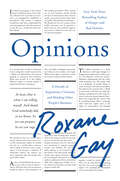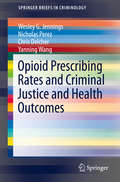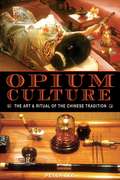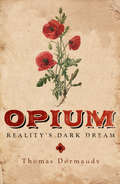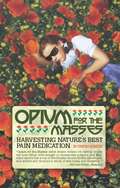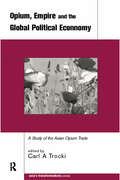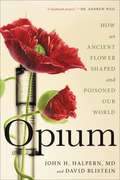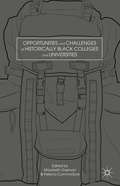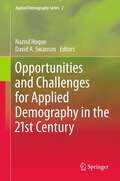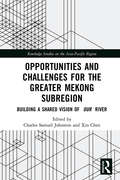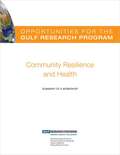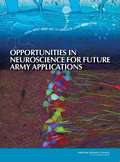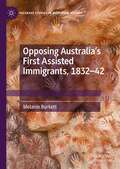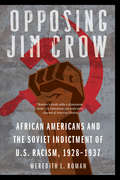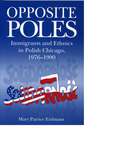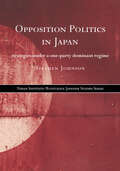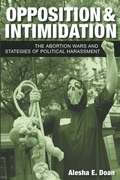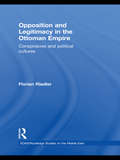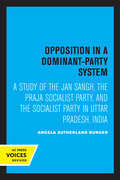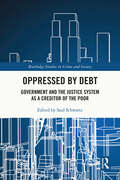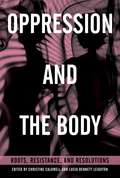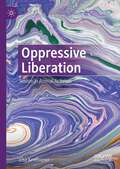- Table View
- List View
Opinions: A Decade of Arguments, Criticism, and Minding Other People's Business
by Roxane GayFrom beloved and bestselling author Roxane Gay, “a strikingly fresh cultural critic” (Washington Post) comes an exhilarating collection of her essays on culture, politics, and everything in between. Since the publication of the groundbreaking Bad Feminist and Hunger, Roxane Gay has continued to tackle big issues embroiling society—state-sponsored violence and mass shootings, women’s rights post-Dobbs, online disinformation, and the limits of empathy—alongside more individually personalized matters: can I tell my co-worker her perfume makes me sneeze? Is it acceptable to schedule a daily 8 am meeting? In her role as a New York Times opinion section contributor and the publication’s “Work Friend” columnist, she reaches millions of readers with her wise voice and sharp insights.Opinions is a collection of Roxane Gay’s best nonfiction pieces from the past ten years. Covering a wide range of topics—politics, feminism, the culture wars, civil rights, and much more—with an all-new introduction in which she reflects on the past decade in America, this sharp, thought-provoking anthology will delight Roxane Gay’s devotees and draw new readers to this inimitable talent.
Opioid Prescribing Rates and Criminal Justice and Health Outcomes (SpringerBriefs in Criminology)
by Wesley G. Jennings Chris Delcher Nicholas Perez Yanning WangThis brief uses California’s CURES (Controlled Substance Utilization Review and Evaluation System) 2.0 data to analyze county-level opioid prescribing rates in California from 2012 to 2017 from multiple perspectives. The book summarizes California’s county-level opioid prescribing trends, examines potential correlates of opioid prescribing rates, and assesses the association of opioid prescribing on both criminal justice and public health outcomes. Finally, the authors discuss their principal findings and the implications for policy and practice, including the significant and lasting consequences of the opioid crisis on the criminal justice system and the importance of a multi-disciplinary approach to effectively address the crisis.
Opioid Reckoning: Love, Loss, and Redemption in the Rehab State
by Amy C. SullivanExamines the complexity and the humanity of the opioid epidemic America&’s opioid epidemic continues to ravage families and communities, despite intense media coverage, federal legislation, criminal prosecutions, and harm reduction efforts to prevent overdose deaths. More than 450,000 Americans have died from opioid overdoses since the late 1990s. In Opioid Reckoning, Amy C. Sullivan explores the complexity of the crisis through firsthand accounts of people grappling with the reverberating effects of stigma, treatment, and recovery. Nearly everyone in the United States has been touched in some way by the opioid epidemic, including the author and her family. Sullivan uses her own story as a launching point to learn how the opioid epidemic challenged longstanding recovery protocols in Minnesota, a state internationally recognized for pioneering addiction treatment. By centering the voices of many people who have experienced opioid use, treatment, recovery, and loss, Sullivan exposes the devastating effects of a one-size-fits-all approach toward treatment of opioid dependency. Taking a clear-eyed, nonjudgmental perspective of every aspect of these issues—drug use, parenting, harm reduction, medication, abstinence, and stigma—Opioid Reckoning questions current treatment models, healthcare inequities, and the criminal justice system. Sullivan also imagines a future where anyone suffering an opioid-use disorder has access to the individualized care, without judgment, available to those with other health problems. Opioid Reckoning presents a captivating look at how the state that invented &“rehab&” addresses the challenges of the opioid epidemic and its overdose deaths while also taking readers into the intimate lives of families, medical and social work professionals, grassroots activists, and many others impacted by the crisis who contribute their insights and potential solutions. In sharing these stories and chronicling their lessons, Sullivan offers a path forward that cultivates empathy, love, and hope for anyone affected by chaotic drug use and its harms.
Opium Culture: The Art and Ritual of the Chinese Tradition
by Peter LeeA detailed study of the history and usage of opium• Explores the use of opium as a major healing herb and a popular relaxant• Details the opium practices adhered to in the Chinese tradition• Includes information on the suppression of opium by the modern pharmaceutical industryOpium. The very sound of the word conjures images of secret rooms in exotic lands, where languid smokers lounge dreamily in a blue haze of fragrant poppy smoke, inhaling from long bamboo pipes held over the ruby flame of the jade lamp. Yet today very little accurate information is available regarding a substance that for 300 years was central to the lives of millions of people throughout the world.In Opium Culture Peter Lee presents a fascinating narrative that covers every aspect of the art and craft of opium use. Starting with a concise account of opium’s long and colorful history and the story of how it came to be smoked for pleasure in China, Lee offers detailed descriptions of the growing and harvesting process; the exotic inventory of tools and paraphernalia required to smoke opium as the Chinese did; its transition from a major healing herb to a narcotic that has been suppressed by the modern pharmaceutical industry; its connections to the I Ching, Taoism, and Chinese medicine; and the art, culture, philosophy, pharmacology, and psychology of this longstanding Asian custom. Highlighted throughout with interesting quotes from literary and artistic figures who were opium smokers, such as Jean Cocteau, Pablo Picasso, Herman Melville, and Samuel Taylor Coleridge, the text is studded with gems of long forgotten opium arcana and dispels many of the persistent myths about opium and its users.
Opium Reality's Dark Dream
by Thomas DormandyOpium and its derivatives morphine and heroin have destroyed, corrupted, and killed individuals, families, communities, and even whole nations. And yet, for most of its long history, opium has also been humanity's most effective means of alleviating physical and mental pain. This extraordinary book encompasses the entire history of the world's most fascinating drug, from the first evidence of poppy cultivation by stone-age man to the present-day opium trade in Afghanistan. Dr. Thomas Dormandy tells the story with verve and insight, uncovering the strange power of opiates to motivate major conflicts yet also inspire great art and medical breakthroughs, to trigger the rise of global criminal networks yet also revolutionize attitudes toward well-being. Opium: Reality's Dark Dreamtraverses the globe and the centuries, exploring opium's role in colonialism, the Chinese Opium Wars, laudanum-inspired sublime Romantic poetry, American "Yellow Peril" fears, the rise of the Mafia and the black market, 1960s counterculture, and more. Dr. Dormandy also recounts exotic or sad stories of individual addiction. Throughout the book the author emphasizes opium's complex, valuable relationship with developments in medicine, health, and disease, highlighting the perplexing dual nature of the drug as both the cause and relief of great suffering in widely diverse civilizations.
Opium for the Masses
by Jim Hogshire"Contrary to general belief, there is no federal law against growing P. somniferum."--Martha Stewart Living"Regarded as 'God's own medicine,' preparations of opium were as common in the Victorian medicine cabinet as aspirin is in ours. As late as 1915, pamphlets issued by the U.S. Department of Agriculture were still mentioning opium poppies as a good cash crop for northern farmers. Well into this century, Russian, Greek, and Arab immigrants in America have used poppy-head tea as a mild sedative and a remedy for headaches, muscle pain, cough, and diarrhea. During the Civil War, gardeners in the South were encouraged to plant opium for the war effort, in order to ensure a supply of painkillers for the Confederate Army. What Hogshire has done is to excavate this vernacular knowledge and then publish it to the world--in how-to form, with recipes."-- Michael PollanFirst published fifteen years ago, Opium for the Masses instantly became a national phenomenon. Michael Pollan wrote a lengthy feature ("Opium, made easy") about Jim Hogshire in Harper's Magazine, amazed that the common plant, P. somniferum, or opium poppies, which grows wild in many states and is available at crafts and hobby stores and nurseries, could also be made into a drinkable tea that acts in a way similar to codeine or Vicodin.With Opium for the Masses as their guide, Americans can learn how to supplement their own medicine chest with natural and legal pain medicine, without costly and difficult trips to the doctor and pharmacy.
Opium, Empire and the Global Political Economy: A Study of the Asian Opium Trade 1750-1950 (Asia's Transformations)
by Carl TrockiDrug epidemics are clearly not just a peculiar feature of modern life; the opium trade in the nineteenth century tells us a great deal about Asian herion traffic today. In an age when we are increasingly aware of large scale drug use, this book takes a long look at the history of our relationship with mind-altering substances. Engagingly written, with lay readers as much as specialists in mind, this book will be fascinating reading for historians, social scientists, as well as those involved in Asian studies, or economic history.
Opium: How an Ancient Flower Shaped and Poisoned Our World
by David Blistein John H. Halpern"A landmark project." -- Dr. Andrew Weil"Engrossing and highly readable." -- Sam Quinones"An astonishing journey through time and space." -- Julie Holland, MD"The most important, provocative, and challenging book I've read in a long time." -- Laurence BergreenFrom a psychiatrist on the frontlines of addiction medicine and an expert on the history of drug use, comes the "authoritative, engaging, and accessible" (Booklist) history of the flower that helped to build -- and now threatens -- modern society.Opioid addiction is fast becoming the most deadly crisis in American history. In 2018, it claimed nearly fifty thousand lives -- more than gunshots and car crashes combined, and almost as many Americans as were killed in the entire Vietnam War. But even as the overdose crisis ravages our nation -- straining our prison system, dividing families, and defying virtually every legislative solution to treat it -- few understand how it came to be. Opium tells the extraordinary and at times harrowing tale of how we arrived at today's crisis, "mak[ing] timely and startling connections among painkillers, politics, finance, and society" (Laurence Bergreen). The story begins with the discovery of poppy artifacts in ancient Mesopotamia, and goes on to explore how Greek physicians and obscure chemists discovered opium's effects and refined its power, how colonial empires marketed it around the world, and eventually how international drug companies developed a range of powerful synthetic opioids that led to an epidemic of addiction. Throughout, Dr. John Halpern and David Blistein reveal the fascinating role that opium has played in building our modern world, from trade networks to medical protocols to drug enforcement policies. Most importantly, they disentangle how crucial misjudgments, patterns of greed, and racial stereotypes served to transform one of nature's most effective painkillers into a source of unspeakable pain -- and how, using the insights of history, state-of-the-art science, and a compassionate approach to the illness of addiction, we can overcome today's overdose epidemic. This urgent and masterfully woven narrative tells an epic story of how one beautiful flower became the fascination of leaders, tycoons, and nations through the centuries and in their hands exposed the fragility of our civilization.
Opportunities And Challenges At Historically Black Colleges And Universities
by Marybeth Gasman Felecia CommodoreIn this edited collection, the authors grapple with both the strengths and challenges that HBCUs face as the nation's demographics change, from their place in American society and growing diversity on HBCU campuses to class and elitism issues to study abroad and honors programs.
Opportunities and Challenges for Applied Demography in the 21st Century
by David A. Swanson Nazrul HoqueApplied demography continues its rapid pace of evolution in concert with the emerging trends of the 21st century. One significant area of change is the extension of applied demography beyond the United States; this book includes material dealing with applied demography in Australia, Canada, Estonia, and Mexico. Opportunities and Challenges for Applied Demography in the 21st Century presents a score of selected papers from the second post-2000 national conference on Applied Demography, held in San Antonio, Texas, in January, 2010, under the sponsorship of the Institute for Demographic and Socioeconomic Research at The University of Texas at San Antonio. Coverage includes the assembly of data by government agencies, with a focus on issues facing the United States; demographic issues associated with globalization; business demography and health demography, as well as a section examining methodological advances in the areas of estimation and projection.
Opportunities and Challenges for the Greater Mekong Subregion: Building a Shared Vision of Our River (Routledge Studies on the Asia-Pacific Region)
The Mekong River is a vital and valuable resource, with huge development potential for the six states through which it flows. Given the significant asymmetry of power between those states, however, there is a real risk that some might utilise it to the detriment of others. Without a sense of regional belonging, it is difficult to imagine that these states and their constituent communities will take regional imperatives to heart, participate in joint regulatory frameworks, or adopt behaviours for upstream-downstream and lateral cooperation over the appropriation and use of their shared resources. How effectively has closer interdependence of the Mekong countries accommodated the development of a political-social-cultural space conducive to the growth of a regional "we-ness" among not only political elites, but also the general public? The contributors to this volume approach this question from a range of directions, including the impacts of tourism, regional development programmes, the Mekong Power Grid, and Sino-US rivalry. This edited volume presents valuable insights for scholars of international relations, Asian studies, development studies, environment studies, policy studies, and human geography.
Opportunities for the Gulf Research Program: Summary of a Workshop
by Leighanne OlsenThere are many connections between human communities and their surrounding environments that influence community resilience and health in the Gulf of Mexico. The impacts of the Deepwater Horizon oil spill on Gulf communities and ecosystems - coupled with the region's preexisting health challenges and environmental stressors - illustrate the need to better understand these connections. In the future, natural and man-made disasters, climate change impacts, and other environmental stressors will present complex challenges to the physical, mental, and social well-being of communities in the Gulf. Understanding the interrelationships among health, ecological, and economic impacts of disasters and other environmental stressors will be crucial to addressing these challenges. Opportunities for the Gulf Research Program: Community Resilience and Health summarizes a Gulf Research Program workshop held on September 22-23, 2014, in New Orleans, Louisiana. The workshop examined opportunities to improve the health, well-being, and resilience of communities in the Gulf region through discussions with about 50 participants with diverse expertise and experience. These discussions identified perceived needs, challenges, and opportunities that align with the Gulf Research Program's mission and goals - particularly its goal to improve understanding of the connections between human health and the environment to support the development of health and resilient Gulf communities. This workshop is expected to lead to the development of additional Program activities and opportunities for the research community.
Opportunities in Neuroscience for Future Army Applications
by National Research Council of the National AcademiesAdvances and major investments in the field of neuroscience can enhance traditional behavioral science approaches to training, learning, and other applications of value to the Army. Neural-behavioral indicators offer new ways to evaluate how well an individual trainee has assimilated mission critical knowledge and skills, and can also be used to provide feedback on the readiness of soldiers for combat. Current methods for matching individual capabilities with the requirements for performing high-value Army assignments do not include neuropsychological, psychophysiological, neurochemical or neurogenetic components; simple neuropsychological testing could greatly improve training success rates for these assignments. Opportunities in Neuroscience for Future Army Applications makes 17 recommendations that focus on utilizing current scientific research and development initiatives to improve performance and efficiency, collaborating with pharmaceutical companies to employ neuropharmaceuticals for general sustainment or enhancement of soldier performance, and improving cognitive and behavioral performance using interdisciplinary approaches and technological investments. An essential guide for the Army, this book will also be of interest to other branches of military, national security and intelligence agencies, academic and commercial researchers, pharmaceutical companies, and others interested in applying the rapid advances in neuroscience to the performance of individual and group tasks.
Opposing Australia’s First Assisted Immigrants, 1832-42 (Palgrave Studies in Migration History)
by Melanie BurkettThis book unravels the paradoxical denigration of the first significant group of free (non-convict), working-class emigrants to the Australian colony of New South Wales in the 1830s. Though their labour was sorely needed, the colonial elite rejected the new arrivals on the grounds that they were ‘lazy’ and ‘immoral’. These criticisms stemmed from political, economic, and cultural motivations that ultimately sought to protect, legitimise, and cement the elite’s financial and social hegemony. The author seeks to explore the ulterior motives behind the public denouncements of immigrants by exposing the conflicting and opportunistic rationales used. Brought to Australia from Britain and Ireland through the experiment of ‘government-assisted migration,’ these immigrants are often remembered as ‘brave pioneers’ today, but this book exposes the deep antagonistic attitudes toward immigration that remain entrenched in Australian society. Uncovering early forms of class antagonism in Australia, this book presents useful insights for those researching Australian history and migration studies, as well as scholars of colonial history, by providing a model for re-evaluating and confronting a long-standing pattern in most settler societies: hostility toward immigrants.
Opposing Jim Crow: African Americans and the Soviet Indictment of U.S. Racism, 1928-1937 (Justice and Social Inquiry)
by Meredith L. RomanBefore the Nazis came to power in Germany, Soviet officials labeled the United States the most racist country in the world. Photographs, children&’s stories, films, newspaper articles, political education campaigns, and court proceedings exposed the hypocrisy of America&’s racial democracy. In contrast, the Soviets represented the USSR itself as a superior society where racism was absent and identified African Americans as valued allies in resisting an imminent imperialist war against the first workers&’ state. Meredith L. Roman&’s Opposing Jim Crow examines the period between 1928 and 1937, when the promotion of antiracism by party and trade union officials in Moscow became a priority policy. Soviet leaders stood to gain considerable propagandistic value at home and abroad by drawing attention to U.S. racism, their actions simultaneously directed attention to the routine violation of human rights that African Americans suffered as citizens of the United States. Soviet policy also challenged the prevailing white supremacist notion that blacks were biologically inferior and thus unworthy of equality with whites. African Americans of various political and socioeconomic backgrounds became indispensable contributors to Soviet antiracism and helped officials in Moscow challenge the United States&’ claim to be the world&’s beacon of democracy and freedom.
Opposite Poles: Immigrants and Ethnics in Polish Chicago, 1976–1990 (G - Reference, Information and Interdisciplinary Subjects)
by Mary Patrice ErdmansOpposite Poles presents a fascinating and complex portrait of ethnic life in America. The focus is Chicago Polonia, the largest Polish community outside of Warsaw. During the 1980s a new cohort of Polish immigrants from communist Poland, including many refugees from the Solidarity movement, joined the Polish American ethnics already settled in Chicago. The two groups shared an ancestral homeland, social space in Chicago, and the common goal of wanting to see Poland become an independent noncommunist nation. These common factors made the groups believe they ought to work together and help each other; but they were more often at opposite poles. The specious solidarity led to contentious conflicts as the groups competed for political and cultural ownership of the community. Erdmans's dramatic account of intracommunity conflict demonstrates the importance of distinguishing between immigrants and ethnics in American ethnic studies. Drawing upon interviews, participant observation in the field, surveys and Polish community press accounts, she describes the social differences between the two groups that frustrated unified collective action. We often think of ethnic and racial communities as monolithic, but the heterogeneity within Polish Chicago is by no means unique. Today in the United States new Chinese, Israeli, Haitian, Caribbean, and Mexican immigrants negotiate their identities within the context of the established identities of Asians, Jews, Blacks, and Chicanos. Opposite Poles shows that while common ancestral heritage creates the potential for ethnic allegiance, it is not a sufficient condition for collective action.
Opposite Sides of the Bed: A Lively Guide to the Differences Between Women and Men
by Cris EvattOpposite Sides of the Bed, formerly titled He & She, explores the sociological, physiological, "and psychological differences between women and men, cites supporting studies, offers suggestions on how to cope and tells you where to go for further reading. Fascinating facts from the most up-to-date research on gender differences Sixty-eight percent of men like the way they look naked; only 22 percent of women do. Women smile more than men, especially when delivering bad news. Women use more adjectives such as wonderful, more diminutives such as cute and more euphemisms. Men are more sensitive to stress. One alcoholic drink for women has about the same effect as two for men. Women cry about five times as much as men; a male hormone may actually suppress tears.
Opposition Politics in Japan: Strategies Under a One-Party Dominant Regime (Nissan Institute/Routledge Japanese Studies)
by Stephen JohnsonThe Liberal Democratic Party in Japan remained in power continuously between 1955 and 1993. In this groundbreaking study of the dominance of the LDP in Japanese politics over the last forty years, Opposition Politics in Japan examines the challenges which were mounted against this regime and explores why they failed. The subjects covered include opportunities for a united opposition during the 1970s, ideological, organisational and electoral aspects of the opposition's lack of response to such opportunities and the causes of opposition fragmentation. The book also looks at attempts at coalition, the influence of the trade unions, the importance of organisational factors and the influence, if any, of the oppositions's Marxist tendencies.A highly original and thorough exploration of the issues, Opposition Politics in Japan is essential reading for all those interested in Japanese politics.
Opposition and Intimidation: The Abortion Wars and Strategies of Political Harassment
by Alesha E. DoanThe abortion fight has long been a crucible of political tactics, with both sides employing strategies ranging from litigation to civil disobedience to outright violence. Anti-abortion activists have arguably been more tactically innovative than their pro-choice peers. Opposition and Intimidation looks at how their use of political harassment fits--or doesn't--with more conventional political efforts in the struggle over abortion. Alesha Doan's insightful interviews and observations powerfully portray anti-abortion activists' relationship to the objects of their protest. Her portrait is augmented by thorough quantitative analysis of harassment's role within the movement's multitiered strategy--a strategy that Doan shows has forced a decline in the availability and popularity of abortions. Using her unique study of the anti-abortion movement as a model, Doan extends her findings to propose a novel and valuable theory of the new politics of harassment.
Opposition and Legitimacy in the Ottoman Empire: Conspiracies and Political Cultures (SOAS/Routledge Studies on the Middle East)
by Florian RiedlerThis book looks at opposition to the Ottoman government in the second half of the nineteenth century, examining a number of key political conspiracies and how these relate to an existing political culture. In his detailed analysis of these conspiracies, the author offers a new perspective on an important and well researched period of Ottoman history. A close reading of police records on five conspiracies offers the opportunity to analyse this opposition in great detail, giving special attention to the different groups of political actors in these conspiracies that often did not come from the established political elites. Florian Riedler investigates how their background of class and education, but also their individual life experiences influenced their aims and strategies, their political styles as well as their ways of thinking on political legitimacy. In contrast, the reaction of the authorities to these conspiracies reveals the official understanding of Ottoman legitimacy. The picture that emerges of the political culture of opposition during the second half of the nineteenth century offers a unique contribution to our understanding of the great changes in the political system of the Ottoman Empire at the time. As such, it will be of great interest to scholars of Middle Eastern history, political history, and the Ottoman Empire.
Opposition by Imitation: The Economics of Italian Anti-Mafia Activism (Diverse Economies and Livable Worlds)
by Christina JerneDefying the mafia with everyday acts of resistance For more than 150 years, Italy has been home to a resilient and evolving resistance against the pervasive influence of mafias. While these criminal organizations are renowned for their vast international business enterprises, the collective actions taken to oppose them are less known. In Opposition by Imitation, Christina Jerne explores anti-mafia activism, revealing how ordinary people resist, counter, and prevent criminal economies from proliferating. Drawing on ethnographic fieldwork among anti-mafia alliances in Campania, Sicily, and other parts of Italy, Jerne details a particular aspect of mafia activities: providing cash relief and other forms of patronage to individuals and groups. Her research shows how activism has evolved to imitate this sustaining role. Activists are increasingly challenging mafia control both by creating alternative economies—from producing food that interrupts mafia labor practices to organizing tourism that supports anti-mafia hospitality—and by subversively adopting business tactics similar to the mafia&’s to compete with their social influence and legitimacy. Exposing the political implications of this mimetic opposition, Jerne points to its potential impact on crime prevention and criminalization, both in Italy and globally. Opposition by Imitation shows how these modern-day Robin Hoods are redefining collective action, taking what was controlled by the mafias and returning it to the collective. This contentious economic turn, against the backdrop of broader social movements, reveals significant political possibilities afforded by imitative opposition. Retail e-book files for this title are screen-reader friendly with images accompanied by short alt text and/or extended descriptions.
Opposition in a Dominant-Party System: A Study of the Jan Sangh, the Praja Socialist Party, and the Socialist Party in Uttar Pradesh, India (Center for South and Southeast Asia Studies, UC Berkeley)
by Angela S. BurgerThis title is part of UC Press's Voices Revived program, which commemorates University of California Press’s mission to seek out and cultivate the brightest minds and give them voice, reach, and impact. Drawing on a backlist dating to 1893, Voices Revived makes high-quality, peer-reviewed scholarship accessible once again using print-on-demand technology. This title was originally published in 1969.
Oppressed by Debt: Government and the Justice System as a Creditor of the Poor (Routledge Studies in Crime and Society)
by Saul SchwartzThis edited collection brings together essays that explore personal debts to government. Intensive collection efforts by governments in need of revenue often cause hardship, whether it is the poor in the United States going to jail because of unpaid fines, low-income English people being evicted because they paid their council taxes but could then not pay their rent, or poor former students having tax refunds or social benefits taken by the government when they have defaulted on their student loans. Student loans, fines and fees arising from the justice system, benefit overpayments and unpaid taxes have all ballooned in the past decade, but no other volume comprehensively addresses the various ways in which governments have become privileged creditors, using their power to collect debts owed to them by their citizens. With each essay emphasizing a particular kind of debt to government, the book focuses on what happens when citizens cannot pay the debts they owe to their governments. Contributors offer pragmatic options to facilitate a movement to soften the stance of governments toward those who owe them money. The insights in this collection will be of relevance to students and academics in criminology, sociology, public policy, and economics, as well as policymakers and government officials interested in effecting change in this area.
Oppression and the Body: Roots, Resistance, and Resolutions
by Christine Caldwell Lucia Bennett LeightonA timely anthology that explores power, privilege, and oppression and their relationship to marginalized bodies Asserting that the body is the main site of oppression in Western society, the contributors to this pioneering volume explore the complex issue of embodiment and how it relates to social inclusion and marginalization. In a culture where bodies of people who are brown, black, female, transgender, disabled, fat, or queer are often shamed, sexualized, ignored, and oppressed, what does it mean to live in a marginalized body? Through theory, personal narrative, and artistic expression, this anthology explores how power, privilege, oppression, and attempted disembodiment play out on the bodies of disparaged individuals and what happens when the body’s expression is stereotyped and stunted. Bringing together a range of voices, this book offers strategies and practices for embodiment and activism and considers what it means to be an embodied ally to anyone experiencing bodily oppression.
Oppressive Liberation: Sexism in Animal Activism
by Lisa KemmererWhile explicitly set against a backdrop of sexism in social justice activism more generally, this book exposes causes, pervasiveness, harms, and possible directions for change with regard to sexism and male privilege in the animal activist movement. Employing the work of previous scholars, Dr. Lisa Kemmerer exposes the commonplace nature and causes of sexism and male privilege in social justice activism, then focuses on anymal activists, including new data that has not previously been published. The book also explores the crushing harms caused by sexism in the movement and an extensive array of possible directions for change. In various places throughout the text, Kemmerer refocuses on the interface of sexism and speciesism, and one full chapter explores a philosophies of interconnection from around the world and down through time. Also included are six essays from contributing authors who offer fresh angles on the topic, and who provide contextualized experiences with intersectional oppressions. While the book focuses specifically on animal activism, the end-goal of the book is total liberation—an end to all forms of privilege and marginalization.
